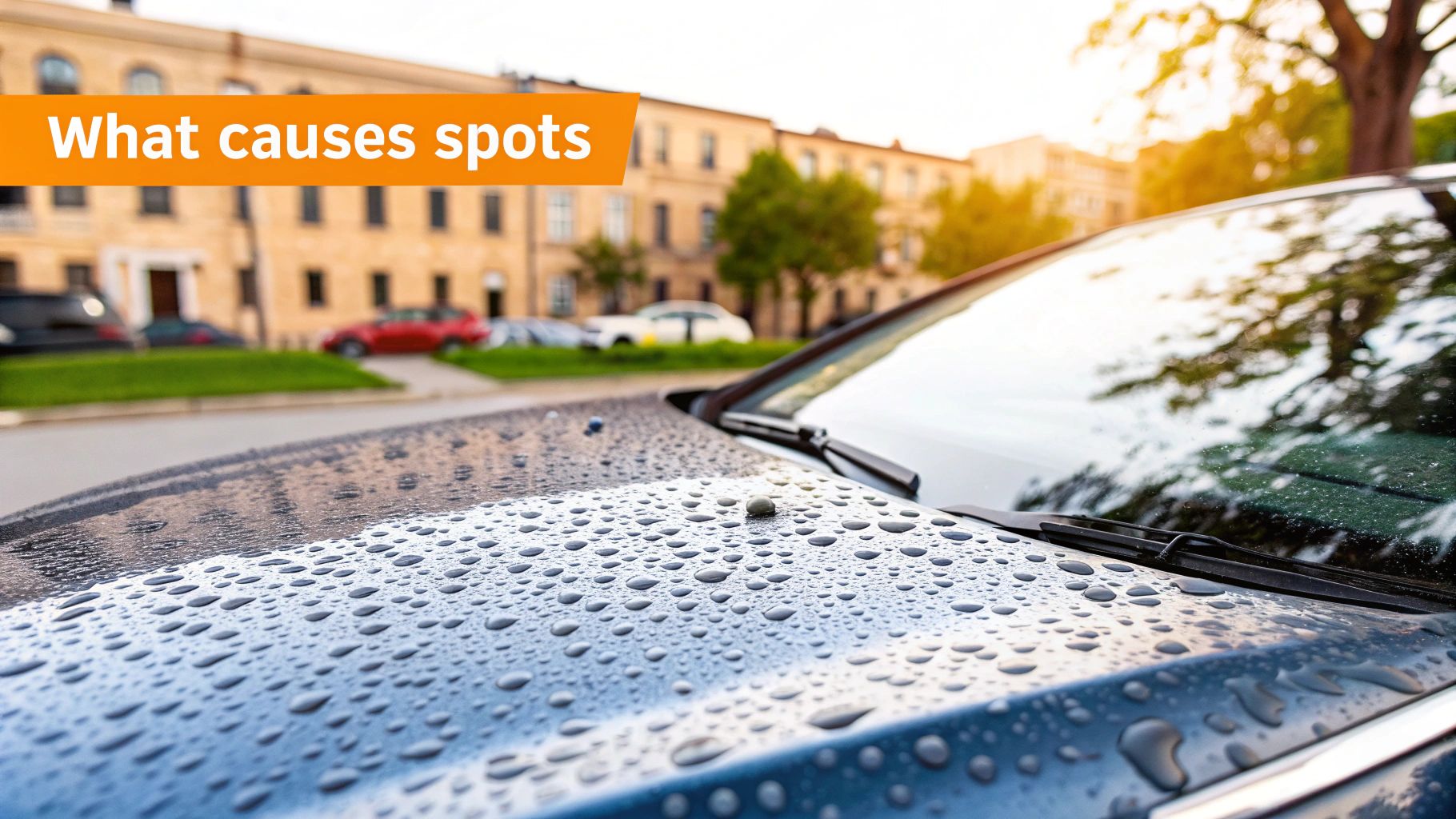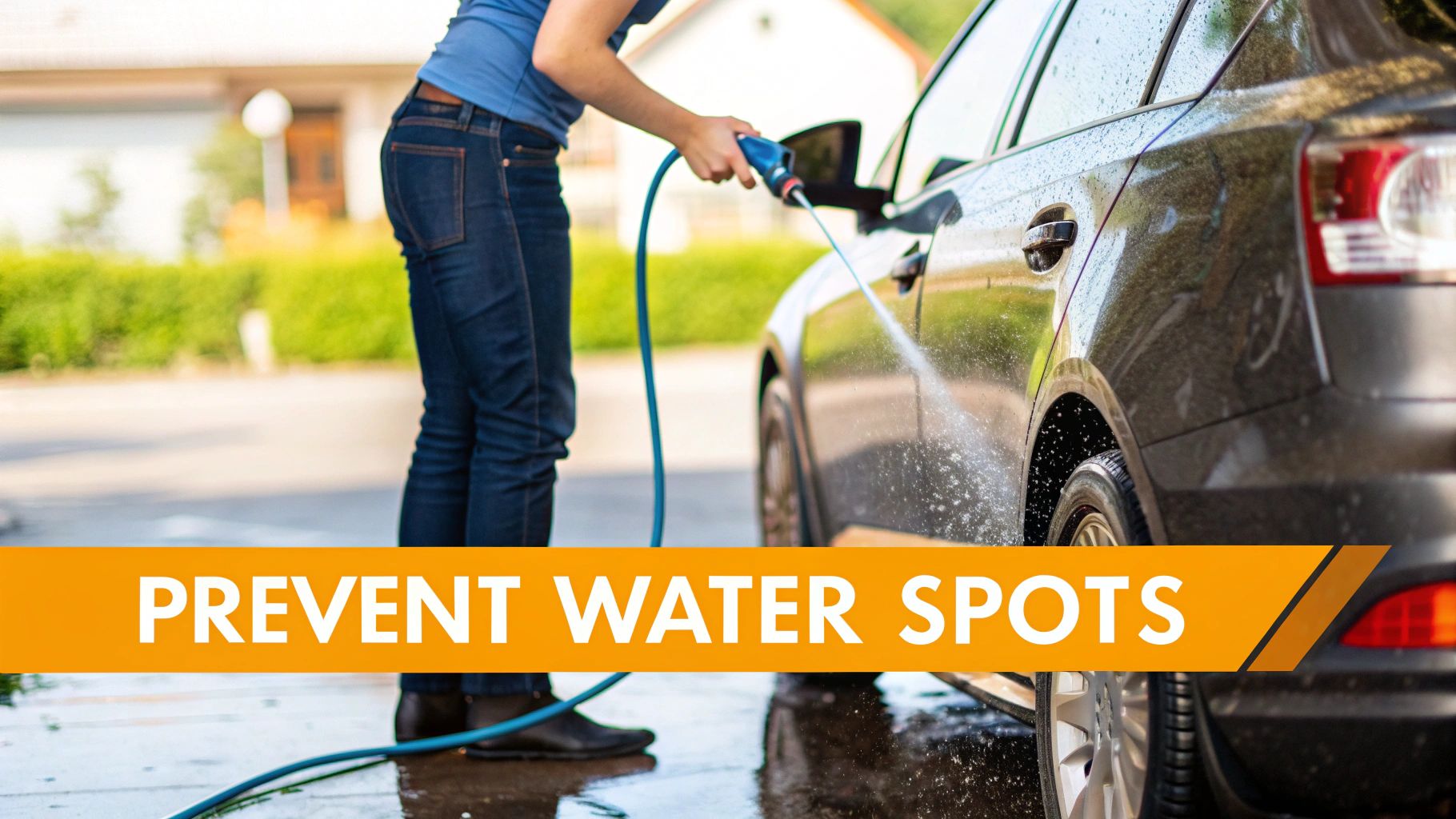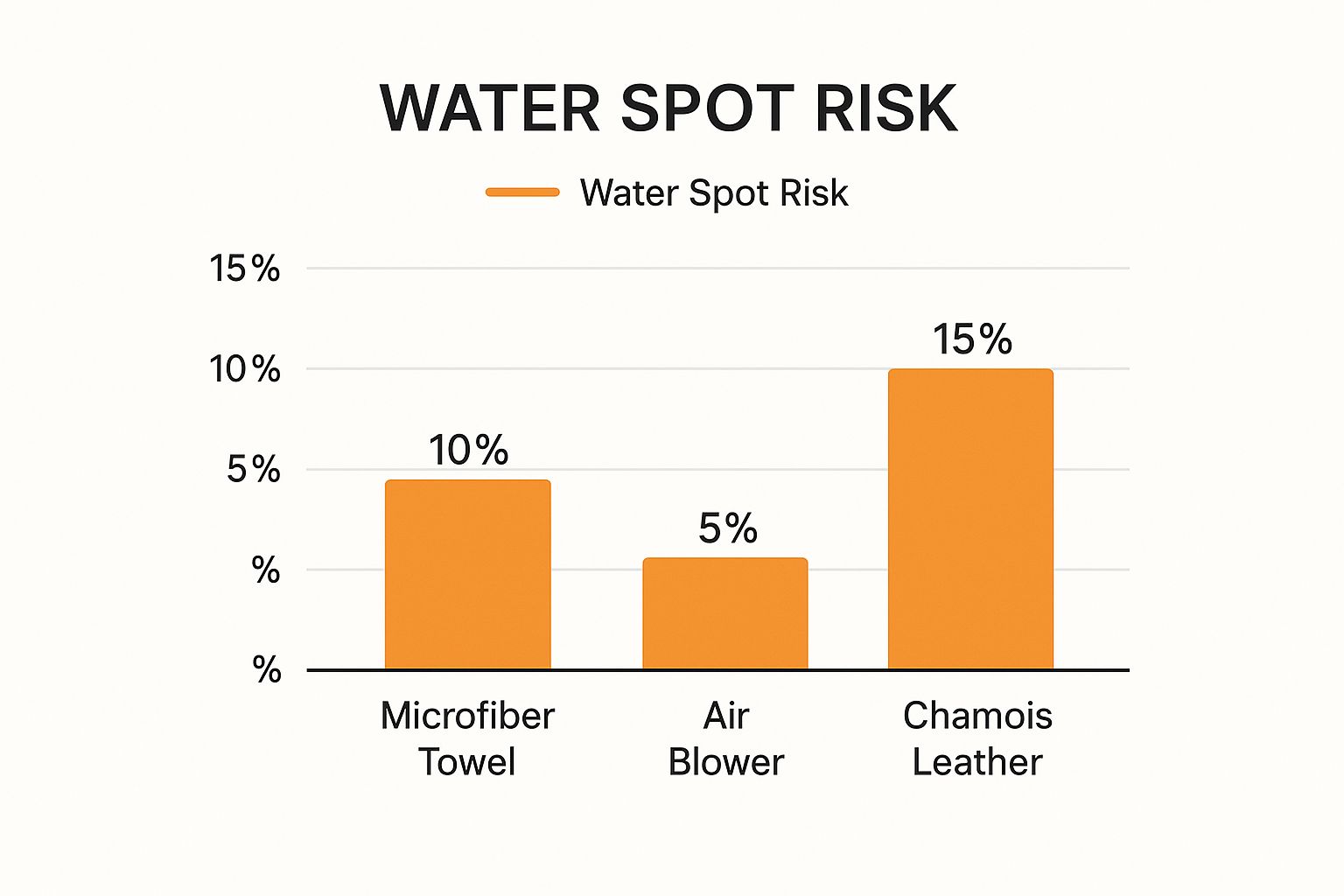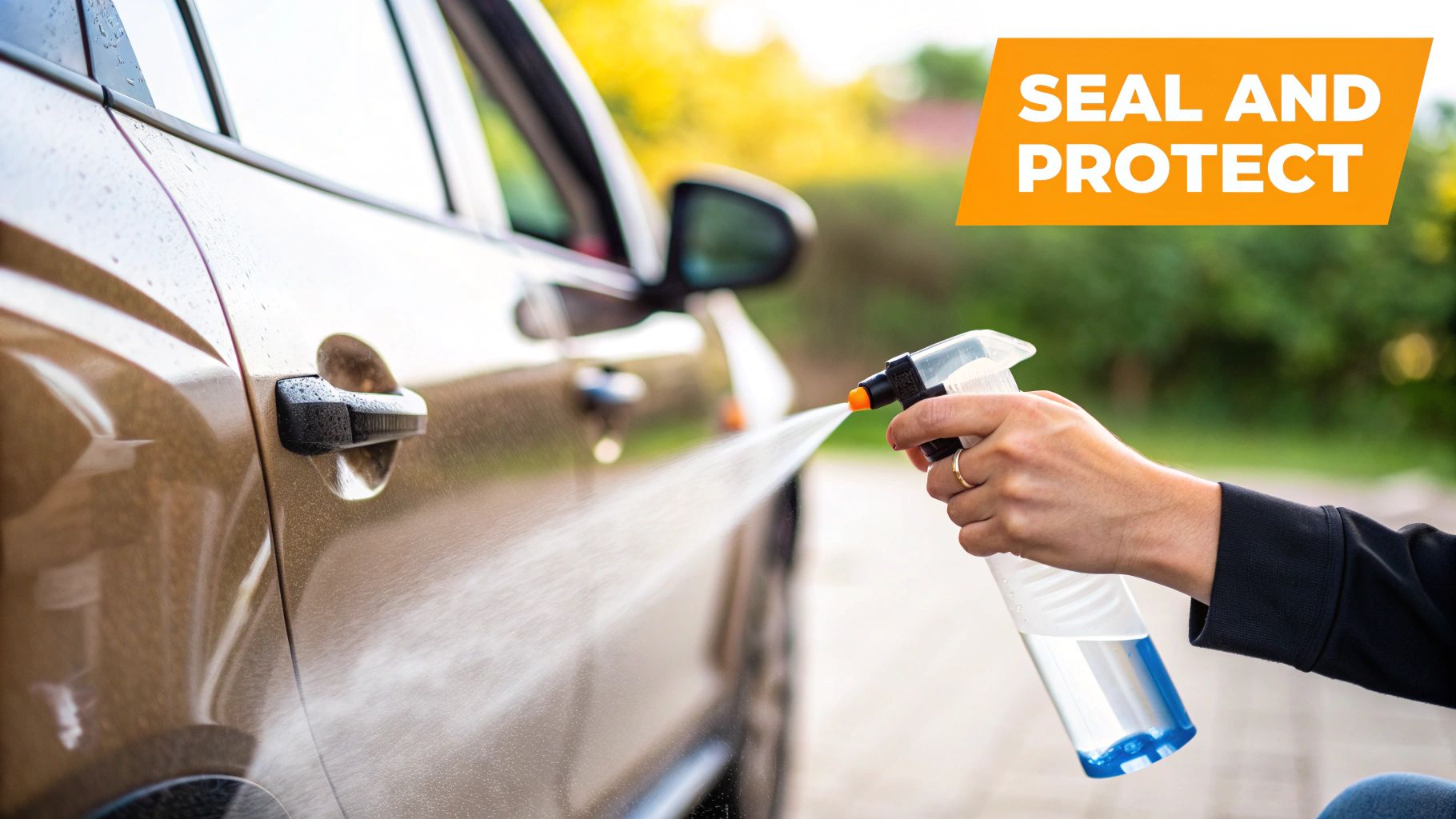If you want to stop water spots from ruining your car's finish, it boils down to two simple things: using the right kind of water for the wash and getting the car completely dry before any of those droplets can evaporate. This is a game of prevention. Stop the minerals from ever clinging to your paint, and you'll never have to deal with those frustrating blemishes in the first place.
Why Do Water Spots Happen, Anyway?

Before we get into the solutions, it helps to know what you’re actually fighting. Those annoying white rings aren't just dried water. They're the tiny mineral deposits that get left behind after the H₂O evaporates, like stubborn little footprints from every single droplet.
This is a huge problem for anyone washing their car with regular tap water. Most tap water is "hard," which is just a term for water loaded with minerals like calcium and magnesium. When a bead of hard water sits on your hot paint and dries, the water goes, but the minerals stay. In the detailing world, we call this a Stage 1 water spot.
From Annoying Blemish to Permanent Damage
At first, these spots are just sitting on the surface. No big deal, right? Wrong. If you let them sit, those minerals can start to bond with and etch into your car’s clear coat. The sun’s heat acts like an oven, baking the deposits right into the paint. This is what leads to permanent damage, or what we call Stage 2 etching.
My Pro Tip: It's always easier—and cheaper—to prevent water spots from forming than it is to fix the damage later. A little bit of smart prevention beats hours of paint correction every single time.
The water source is almost always the main culprit. It's not just your garden hose, either. Keep an eye out for other common sources of spot-causing water:
- Lawn Sprinklers: These are notorious for spraying hard, untreated water all over your clean car.
- Acid Rain: This isn't just water; it's carrying pollutants that leave behind corrosive deposits.
- Washing in Direct Sunlight: This is the big one. It turbo-charges evaporation, giving you zero time to dry your car properly.
To truly fix the problem, you have to start with the water itself. Learning how reverse osmosis (RO) water purification systems work is a great first step, as they strip out the minerals that cause spots. For more on-the-spot solutions, check out our guide to mastering hard water car washes for some of my go-to strategies.
Your Spot-Free Car Wash and Dry Method

The single biggest chance you have to stop water spots is during the wash and dry process itself. This is where the battle is won or lost. Getting your technique dialed in here is the foundation for a flawless, mirror-like finish.
It really begins with the water you use. If you can get your hands on filtered or deionized water, you're already playing on easy mode. This type of water has had most (if not all) of the spot-causing minerals stripped out.
Next, you need a high-quality, pH-neutral car shampoo. Soaps that are too acidic or alkaline can actually strip off your wax and sealant, leaving your paint unprotected and sometimes even leaving their own residue behind.
The Right Environment and Tools
Where and how you wash your car is just as important as what you use. The golden rule every detailer lives by is to never wash your car in direct sunlight or when the body panels are hot.
Heat is the enemy. It causes water and suds to evaporate way too quickly, leaving those pesky mineral deposits all over the place before you even have a chance to rinse and dry. Your best bet is to work in a shaded spot, inside a garage, or during the cooler parts of the day, like early morning or late afternoon.
The right tools don't just make the job easier; they give you better results. This is where a foam gun, like the SwiftJet, really shines. It hooks right up to your garden hose and blankets your car in a thick, clinging foam. This isn’t just for show—the foam lubricates the surface and starts lifting dirt away from the paint, which drastically cuts down the risk of swirl marks.
When you pre-soak the car with foam, you’re letting the soap do the heavy lifting before you ever touch the paint with a wash mitt. It’s a simple step that makes the whole wash safer for your clear coat and much more effective at getting rid of stubborn grime.
Master the Art of Drying
How you dry the car is the final, make-or-break moment in the fight against water spots. Letting your car air-dry is basically asking for trouble.
- Plush Microfiber Towels: A large, high-quality microfiber drying towel is non-negotiable. Forget aggressively rubbing the paint. Instead, try the "blot" or "drape and drag" method. Just lay the towel flat across a panel, give it a moment to soak up the water, and gently pull it off. It’s super effective and much kinder to your paint.
- Air Blower: For a truly touchless dry, a powerful leaf blower or a dedicated car dryer is a game-changer. It forces water out of all the tricky spots—around mirrors, emblems, and panel gaps—where towels can't reach and water loves to hide, only to drip out later.
The demand for products that help achieve that perfect, spot-free shine is huge. The global car care market is valued at around USD 4.68 billion and keeps climbing as more owners look for better ways to maintain their vehicles. You can see more on these trends in this car care products market report.
Ultimately, a methodical approach is what separates a good wash from a great one. For a deeper dive into specific techniques, check out our guide on the best way to dry a car after washing. Nail your wash and dry, and you'll stop water spots for good.
Choosing the Right Paint Protection
If you want to stop fighting water spots, you have to get ahead of the problem. The best defense is a good offense, and in car care, that means creating a barrier so slick that water can't stick around long enough to cause trouble. This is where long-term paint protection comes in, turning your car’s surface into a hydrophobic shield that forces water to bead up and roll right off.
There are a few great options out there, from traditional waxes to advanced ceramic coatings. Each one offers a different balance of durability, shine, and cost, so you can pick what works best for you.
Waxes, Sealants, and Coatings
A classic carnauba wax is the old-school favorite for a reason. It delivers a deep, warm gloss that’s hard to beat, but being a natural product, it only hangs on for about one to three months. It's perfect if you actually enjoy the ritual of waxing your car and are chasing that ultimate show-car shine.
Moving up the ladder, we have paint sealants. These are fully synthetic polymers engineered to bond directly with your car's paint. The result is a slick, tough layer of protection that typically lasts between four and six months, offering fantastic water repellency. They’re a solid, practical choice for most car owners.
For the ultimate defense, nothing beats a ceramic coating. This isn't just a layer on top of your paint; it's a liquid polymer that chemically bonds with the clear coat, creating a semi-permanent, hardened shell. It becomes a functional part of your car’s surface.
The real magic of a ceramic coating is its intense hydrophobicity. Water forms into tight, perfect little beads and just glides off, taking dirt and mineral contaminants along for the ride. This self-cleaning effect is what makes it so incredibly effective at preventing water spots from ever forming.
The image below shows how different drying techniques play a role, but having a hydrophobic surface makes every method safer and more effective.

As you can see, even the best methods have some risk. An air blower is the safest bet, but a protected, water-repellent surface is your best insurance policy against spots, no matter how you dry.
Making the right choice can feel overwhelming, so here’s a quick breakdown to help you compare your options.
Comparing Car Paint Protection Options
| Protection Type | Durability | Water Repellency | Application Effort |
|---|---|---|---|
| Carnauba Wax | 1-3 Months | Good | Low |
| Paint Sealant | 4-6 Months | Very Good | Medium |
| Ceramic Coating | 2+ Years | Excellent | High (Pro recommended) |
Ultimately, the best protection is the one that fits your needs and how much time you want to spend on maintenance. Any of these will be a massive upgrade over unprotected paint.
It’s no surprise that people are investing more in keeping their cars pristine. The global car wash market has grown to an estimated USD 35.39 billion recently, proving that drivers want more than just a quick rinse—they want lasting protection. You can dive deeper into these car wash trends at SwiftJetUSA.com to see how modern car care is evolving.
How to Safely Remove Existing Water Spots

Even with the best preventative routine, a surprise rain shower or a rogue sprinkler can leave its mark. When you find those frustrating little circles on your paint, the key is to start with the gentlest method possible and only get more aggressive if you have to. This approach protects your paint from any unnecessary wear and tear.
For fresh, light spots, I always reach for a quality quick detailer spray first. Just mist the area, let it sit for a few seconds to start breaking down the mineral deposits, and gently wipe it away with a clean, plush microfiber towel. More often than not, this is all you'll need for minor spotting.
Tackling More Stubborn Mineral Deposits
So what happens if the detail spray doesn't cut it? If the spots are still there, it means the minerals have started to bond more firmly with your car’s clear coat. Now you’ll need a product specifically designed to dissolve those deposits without harming the paint.
Crucial Safety Tip: Before you go all-in with any new chemical or compound, always test it on a small, hidden area first. A spot inside the door jamb or under the hood is perfect. This quick check ensures the product plays nice with your vehicle’s finish.
A dedicated water spot remover is your next best friend. These products typically use a mild acidic formula that is safe for your paint but effective at dissolving the alkaline mineral buildup. Follow the directions on the bottle, which usually involves applying a small amount to a microfiber applicator, gently working it into the surface, and then buffing it off.
When Light Polishing Is Necessary
For the really stubborn spots—the ones that have started to lightly etch into the clear coat—you may need to break out a light polishing compound. This is a more advanced technique because you're physically abrading a microscopic layer of the clear coat to level the surface and erase the etching.
- By Hand: You can do this by hand for smaller areas. Apply a small dab of compound to a foam applicator pad and work it into the paint using small, overlapping circular motions with gentle, even pressure.
- With a Polisher: If you're dealing with more significant etching, a dual-action (DA) polisher paired with a light finishing pad is the safest and most effective tool for the job.
This step physically removes the damage the minerals have left behind. For a deeper dive into the different types of spots and how to handle them, check out our detailed guide on real-world solutions to remove water spots from your car.
Daily Habits for a Consistently Spotless Car
Keeping your car looking pristine isn't about spending entire weekends detailing it. The real secret lies in the small, consistent habits that protect your paint day in and day out. Honestly, the best way to fight water spots is to prevent them from happening in the first place.
Think of it as turning proactive care into a simple, everyday routine.
One of the smartest things you can do is be ready for the unexpected. I always keep a small detailing kit in my trunk, and it's been a lifesaver more times than I can count. It doesn't have to be anything fancy—just a good quality quick detailer spray and a couple of clean microfiber towels. This simple setup lets you deal with bird droppings or tree sap immediately, before the sun has a chance to bake them into your clear coat.
Be Smart About Where You Park
It sounds almost too simple, but where you park your car every day makes a huge difference. Making a conscious choice here can save you hours of polishing and correction work later on.
- Lawn Sprinklers are the Enemy: This is a big one. Those sprinkler systems often spray hard, mineral-rich water that is a guaranteed recipe for stubborn water spots all over your paint and glass.
- Trees Aren't Always Your Friend: Parking under a tree for shade seems like a great idea, but you're just inviting sap, pollen, and bird droppings to ruin your finish.
- Cover is King: If you have the option, always park in a garage or under a carport. This is your best defense against everything from morning dew to those surprise pop-up rain showers.
If you're someone who has to park outside most of the time, seriously consider investing in a high-quality, breathable car cover. It's a physical shield against rain, dust, and all the other gunk floating around, keeping your car cleaner and drier between washes.
These little habits might seem minor, but they compound over time. By thinking ahead and being prepared, you’re basically integrating paint protection into your daily life. It ensures all that effort you put into washing and waxing your car isn't wasted by a rogue sprinkler or a bad parking choice.
Your Top Car Water Spot Questions Answered
We hear a lot of the same questions about tackling water spots, so let's clear up some of the common myths and concerns.
Is It Safe to Use Vinegar on Water Spots?
I see this tip all over the internet, and while a diluted vinegar mix might work on very light spots, it's a gamble I wouldn't recommend. Vinegar is acidic, and that acidity can be harsh on your car's clear coat.
Worse yet, it will absolutely strip off any wax or sealant you've painstakingly applied. Your best bet is always a dedicated, pH-neutral water spot remover designed specifically for automotive paint. It's just not worth the risk to your finish.
But It's Just Rain—How Can It Cause Spots?
This is a big one. It's easy to think rainwater is pure, but it's actually full of junk. As rain falls through the atmosphere, it picks up all sorts of pollutants and contaminants.
When this dirty water—often called "acid rain"—sits on your car and evaporates, it leaves all that grime behind in a concentrated little circle. That residue can be surprisingly damaging, sometimes even etching itself into your paint.
The takeaway here is simple: any water left to dry on your paint is a potential problem. It doesn't matter if it's from the sky, a sprinkler, or a quick rinse with the hose. The minerals and pollutants are the enemy.
How Often Do I Need to Wax to Prevent Water Spots?
There’s no single answer to this because it really comes down to what kind of protection you have on your car. Here’s a quick breakdown of what you can expect:
- Traditional Carnauba Wax: This gives you that beautiful, deep shine but has the shortest lifespan. Plan on reapplying every 1 to 3 months.
- Synthetic Paint Sealant: A big step up in durability. These usually offer solid protection for 4 to 6 months.
- Ceramic Coating: This is the ultimate defense. A professionally applied coating can last for years with the right maintenance, making it a fantastic long-term solution.
Ready to make your wash routine safer and more effective? The SwiftJet foam gun transforms your garden hose into a professional-grade foamer, lifting dirt away to prevent scratches and making your wash faster. Get yours today at https://swiftjetusa.com.
